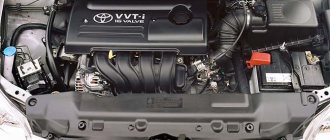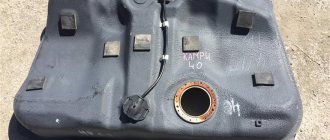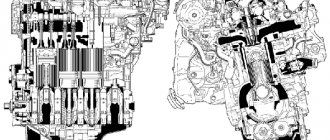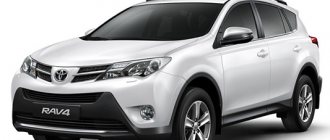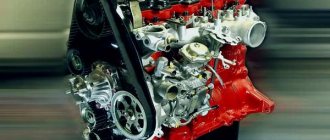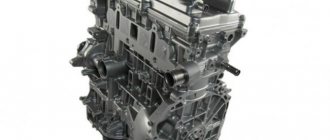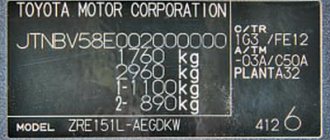3ZR-FAE is considered one of the best developments by Toyota engineers. Experts have significantly improved the characteristics of the power unit, making it more powerful, but at the same time economical. In the new development, fuel consumption is approximately 10 liters when moving around the city. There are many positive reviews regarding this power unit; drivers claim that this is one of the best engines in its series. The use of internal combustion engines began in 2014 and is still installed today, since it is very popular all over the world and is in great demand among people planning to purchase a car.
Disadvantages and weaknesses of 3ZR
The disadvantages of the 3ZR engines were inherited from the ZZ series power units. These include: increased oil consumption, noise, pump leakage, vibrations at idle, and relatively low service life.
The problems that most often make themselves felt to car owners are presented below:
Avensis T270 dorestayl
1) the inability to carry out major repairs of the internal combustion engine;
2) stretching of the timing chain, leading to increased noise (eliminates by replacing the part);
3) strong vibration at idle, which cannot be eliminated by replacing the pillows (a design feature of 3zr engines);
4) poor starting when cold and knocking in the timing belt (it is necessary to monitor the quality of the fuel and change filters on time);
5) failures in operation during start (the problem can be corrected by resetting the control unit);
6) rapid clogging of fuel filters when using low quality fuel;
7) breakdown of hydraulic compensators when using poor quality oil;
 rapid failure of valve seals (only regular replacement helps).
rapid failure of valve seals (only regular replacement helps).
Gas distribution mechanism
It is possible to increase the resource of the power unit only through the use of high-quality oil, regular oil changes and moderate loads.
Nominal and actual motor life
A timing chain is used as a timing drive in all crossover gasoline engines. Its service life is noticeably higher than that of other representatives of this car segment - 150 thousand km. Owners of Rav 4 note that after this mark its stretching begins, therefore, it is not recommended to operate the car on the same chain for longer than 150,000 km. With high-quality and timely maintenance, the two-liter naturally aspirated 1AZ-FE engine covers at least 300 thousand km. Cases when this engine traveled 400 and even 500 thousand kilometers are not isolated. There is considerable potential in this modification of the power plant.
Another 2.0-liter naturally aspirated engine, the 3S-FE, has approximately the same resource. This is a fairly reliable power unit, an exact copy of the 2.2-liter engine from the Toyota Camry, but with one difference - it does not have balance shafts. The motor works perfectly on the AI-92, its valves do not suffer in the event of a timing drive break. Along with the drive, the roller and pump are also replaced. The main thing is to respond to the slightest malfunction in a timely manner, as well as replace consumables with high-quality analogues or original parts.
Article on the topic: We disinfect the car air conditioner ourselves
The 2.2-liter AD-FTV turbodiesel is equipped with a belt drive. As a rule, the engine does not cause any special problems during the first 250-280 thousand kilometers. Afterwards, you may need to replace the injectors, which are seriously affected by low-quality fuel. Often, owners have to clean the VRV and EGR vacuum valve ahead of schedule. In some cases, these elements fail prematurely. Replacing them costs 30-50 thousand rubles. Potentially, the 2.2-liter engine is capable of traveling 300 thousand km on Russian roads. To extend the service life of the unit, it is recommended to clean the injectors every 10-15 thousand kilometers.
3ZR variants
The 3ZR engine has three modifications - 3ZR-FE, 3ZR-FAE and 3ZR-FBE. The main modification is the first on the list. The internal combustion engine of Toyota cars, equipped with two camshafts for intake and exhaust valves, produces 143 hp. The FAE engine is improved with the Valvematic system. Its peculiarity is that the control unit, depending on the driving mode, gives a signal to change the stroke length of the intake valves. The system also selects the optimal fuel assembly composition. The power here is higher and is already 155 hp. Otherwise, the differences in technical characteristics are minor. FBE engines are designed to run on biofuel and are capable of producing 151 hp. This modification is found on Brazilian Toyota Corolla cars.
Tuning
Increasing pumping power, reducing resistance and improving cylinder purging (together atmospheric tuning) do not provide significant changes in the operation of the 3ZR series engine.
Noticeable changes in performance can be achieved by flashing the electronic control unit (ECU), modifying the cylinder head (expanding the channels due to boring), and replacing injectors with more efficient ones. This procedure is called porting or porting. The result will be an increase in engine power by 15-20 hp.
Installing an SC 14 compressor in combination with injectors from the 2ZZ-GE engine allows you to increase power to 180 hp. Fans of upgrading the 3zr engine prefer this option.
3ZR-FAE
Using a Garret GT28 turbine in combination with replacing the injectors, ECU, fuel pump and exhaust system will help extract up to 300 hp from the internal combustion engine. But such high power indicators will certainly have a detrimental effect on the resource of the unit, which already does not shine with longevity.
Toyota RAV4 IV (CA40 / 2013-2019) – Fantasy Island
Toyota RAV4 is built on a modified platform of the extended L version of its predecessor with the index XA30. The third RAV 4 with a standard body could not boast of a roomy interior; a stroller could barely fit in the trunk, and its lid opened to the right. In the fourth generation, the errors were corrected. The wheelbase increased by 10 cm, and the body length by 13 cm. As a result, there was more space in the second row than in the Mazda CX-5 and Volkswagen Tiguan. The trunk volume increased to 547 liters, and its door began to open upward.
In 2015, the crossover underwent restyling. The design of the front part has changed, the bumpers have been updated, and the list of equipment has expanded.
Initially, Toyota RAV 4 was supplied from Japan, and since August 2016 it began to be assembled in St. Petersburg.
In crash tests according to EuroNCAP, the RAV4 earned five stars. According to testing results from the American organization IIHS, the result was a failure. It's all about a more stringent test methodology, which involves testing for a frontal impact with a small overlap.
After improvements in 2015, repeated tests were carried out. It turned out that the driver's side had been strengthened, but the right side remained vulnerable to a small overlap frontal impact.
Engines
The RAV4 engine line is represented by three units: two gasoline and one diesel. Basic – 2-liter petrol (3ZR-FE / 146 hp). Top-end – 2.5 liter naturally aspirated petrol (2AR-FE / 180 hp). The turbodiesel with the commercial designation D-4D has a capacity of 2.2 liters (2AD-FTV) and develops 150 hp. The hybrid version was not available in Russia.
The timing drive of all motors is chain. There are no problems with it yet. There are no complaints about the reliability of the engines themselves and attachments.
Only in 2-liter engines did incidents occur from time to time with the current pump (3-7 thousand rubles). A small batch of diesel engines was subject to warranty replacement due to a defective cylinder head gasket.
Transmission
The 6-speed manual gearbox and Multidrive S continuously variable transmission rely only on the 2-liter petrol engine. The naturally aspirated 2.5, along with the diesel 2.2, was combined with a 6-speed automatic transmission (U660E/U760E). Both automatic transmissions were developed by Aisin, owned by Toyota.
The owners are most concerned about the variator. But in reality it demonstrates good reliability. Yes, breakdowns did happen, but very rarely. The cost of repairs is about 140,000 rubles.
One of the conditions for the longevity of the variator is regular oil renewal. The cost of the procedure with replacing the filter and gaskets within the walls of the dealer service will be about 19,000 rubles, and in a regular service - about 10,000 rubles.
All-wheel drive system
Only RAV 4 with a basic 2.0-liter gasoline engine could be front-wheel drive. Other versions were all-wheel drive.
The all-wheel drive system uses an electromagnetic clutch mounted in front of the rear differential. It adjusts the torque distribution between the front and rear wheels in the range from 0:100 to 50:50. There is also a locking electromagnetic clutch (50:50), which is active until a speed of 40 km/h is reached.
The transmission is reliable. Only after 80-120 thousand km did some owners have to change the driveshaft crosspieces (8-9 thousand rubles including work).
Chassis
The front axle of the RAV4 has MacPherson struts, and the rear axle has a multi-link design. The chassis is quite durable. Only the bushings (every 40-50 thousand km) and struts (after 60-90 thousand km) of the front anti-roll bar need periodic updating.
Rear suspension silent blocks can wear out after 100-150 thousand km. At high mileage, sometimes difficulties arise with adjusting the geometry of the rear wheels due to souring of the camber bolts.
Shock absorbers run over 100-150 thousand km.
In some cases, the front wheel bearings had to be changed after 80-120 thousand km. The bearings come assembled with the hub and will cost 6-10 thousand rubles.
Often you have to change hub studs (50-200 rubles) that were torn off during wheel replacement.
Other problems and malfunctions
The body hardware of the Toyota RAV 4 is not blooming yet. Sometimes comments arise about the paintwork. Chips form on the hood and roof (closer to the windshield). Exposed metal on the roof may bloom.
Occasionally there are complaints about cracking of the paint coating on the surface of the sealant applied on the inside of the doors.
Some owners complain about fogging taillights. In addition, the lights had to be replaced under warranty due to cracks.
After 50-100 thousand km, there are complaints about worn door stop latches. A repair kit for all 4 doors is available for 1,100 rubles, and one complete stopper is available for 1,200 rubles.
Scuffs on the steering wheel could appear after 20-60 thousand kilometers. The steering wheel was replaced under warranty, some twice. Over time, the coating on the automatic transmission handle and silver door trim wears off.
In some instances, the ceiling upholstery became wet due to condensation. Toyota prescribed to eliminate the disease by installing felt material of a larger area.
A number of RAV4s produced at the end of 2015-2017 were subject to a recall campaign due to a fire hazard. The culprit is heated windshield washer nozzles. Due to the defect, water got onto the heating element, which threatened a short circuit and ignition. Unpleasant incidents took place.
Is it worth buying?
All complaints, as a rule, occur infrequently and have not yet become widespread. In addition, many of the flaws are insignificant. The fourth generation Toyota RAV4 can be fully recommended as a reliable and unpretentious family car.
Strengths and weaknesses of the 3ZR-FE
Overall the engine was a success. Powerful and economical, it exhibits stable torque characteristics throughout almost the entire crankshaft speed range. Equipping the Valvematic system had a positive effect on the responsiveness of the 3ZR-FE to pressing the accelerator pedal and to sudden changes in load characteristics.
The disadvantages are quite common. Lack of repair dimensions for the cylinder block. The timing chain drive is implemented so poorly that it is time to talk about an engine life of 200,000 km, that is, before the chain fails.
Due to the Dual VVT-I system, oil for 3ZR-FE should be selected especially carefully. Too thick, it will lead to breakdown of the gas distribution mechanism. Most experts recommend 0w40.
Reviews from Toyota RAV 4 owners
The 2.5-liter gasoline engine appeared relatively recently. It is not yet possible to say unambiguously what its resource is in practice. However, there is no doubt about the high build quality of the power plant. 2AR-FE has proven itself to be the best since it was installed on the Toyota Camry. It is structurally perfect, has no obvious shortcomings and chronic “sores”. Perhaps the only weakness of the modification is that the 2AR-FE cannot be overhauled. On the other hand, with systematic maintenance, the engine can operate for 400 thousand kilometers. The owner's reviews will provide a comprehensive answer about the service life of the Toyota Rav 4 engine.
Engine 2.0 (1AZ-FE, 3S-FE, 3ZR-FAE)
- Kirill. Novokuznetsk. In 2002, I purchased a Toyota RAV 4, generation 2, 1AZ-FE engine. Now the odometer shows 280 thousand km. So far, the engine feels good: it starts easily, I don’t add oil, and there’s no black smoke coming out of the exhaust pipe. I always adhered to the maintenance regulations and only filled in the recommended oil. The only thing I don't like is the cylinder block of the installation. It is made of aluminum, and cast iron sleeves are pressed into it. It is almost impossible to carry out a capital project, although some craftsmen take on such work and give a guarantee of 20 thousand km, which, of course, is ridiculous. I hope the car will last another 100-120 thousand; crossovers cost 400,000 with such an engine.
- Sergey, Kazan. Many people say that a major overhaul on 1AZ-FE is impossible, so I hasten to dispel the myths. In 2010, I got a Rav 4, 3rd generation with a 2.0-liter “dead” engine. The car was produced in 2007, and at that time the mileage was 50 thousand kilometers. In general, the previous owner never changed the oil at all, plus the engine constantly overheated. 1AZ-FE is terribly afraid of overheating, no matter what the mileage is. In general, I bought the car at a good price and decided to repair the engine. What we did: grinding the cylinder head, replacing parts of the connecting rod and piston group and rings, cleaning the crankcase ventilation. The repairs cost 70 thousand rubles. Now the mileage is already 200 thousand kilometers, the flight is normal.
- Yuri, Moscow. I have a Toyota RAV 4 3S-FE, 1st generation, 1998. Now the car is already 20 years old. During this time, 400,000 km were covered. No major repairs were done. I know many who have already undergone the same modification for half a million and no matter what. This assembly is sensitive to engine oil quality. It’s not worth pouring anyhow. For 3S-FE engines produced before 1996, the recommended oil with a viscosity of 5W40 is best suited, and for those produced after 1996 - 5W30. You only need to pour a quality product. Chain resource – 150,000 km. The engine is of high quality, reliable, and the hassle of trifles begins only after crossing the 200,000 km mark.
- Albert, St. Petersburg. I have a Toyota 3ZR-FAE, a 2010 car. There are no complaints about the quality of the car. The power unit is pleasing; over 160,000 km of mileage it actually didn’t bother me at all. Requires only high-quality oil and fuel. “Maslozhor” did not notice, on average it consumes 8 liters per 100 km. There were problems only with the control unit, but in the end it was quickly resolved at the service center. Overall, another high-quality unit from Japanese engineers.
There is no doubt about the reliability and quality of naturally aspirated power plants of the Toyota Rav 4 with a displacement of 2 liters. Potentially, they can last half a million, and only because of a careless attitude towards motors and non-compliance with scheduled maintenance regulations, in most cases these motors exhaust their service life at the turn of 300 thousand km.
Article on the topic: Measuring engine oil pressure and searching for causes is not normal
Engine 2.2 (2AD-FTV turbodiesel)
- Alexey, Novorossiysk. Toyota Rav 4, 2013, 2.2 liter turbodiesel, power 150 horsepower. Already covered 75 thousand km. There were no problems. You can get the most out of a diesel engine if you follow some rules. Replace the fuel filter every 30 thousand km, oil every 7-8 thousand km, fill only with the recommended one. Treat the turbine with care; after long trips, do not immediately turn off the engine, let it run for 10 minutes without load. This engine is picky about the quality of diesel fuel. Even one unsuccessful refueling can break the engine. At a service station they recently told me that the resource of a turbodiesel is quite long, but what exactly it is is anyone’s guess. No official data, only personal experience. I assume that 2AD-FTV is capable of passing 300-350 thousand.
- Vyacheslav, Tula. I bought the car in 2015, 2.2 liter turbodiesel. In three years I covered 60,000 km. I travel a lot, I went on a long trip around Russia. What can I say about the car and its engine? The crossover feels great at low revs, I especially like driving the Rav 4 along serpentine roads. It pulls well uphill, no problems. In terms of dynamics – playful and cheerful. The dealership said that with proper maintenance there will be no problems at all up to 200 thousand km. They recommended filling the Lukoy with ECTO diesel, saying that the engine would not experience any problems with it, and there would be no breakdowns in the fuel system. Let's see.
Owners of the turbodiesel modification note the high dynamic performance of the car. The diesel engine operates quietly and no extraneous sounds are heard into the cabin. At the same time, the engine is quite reliable - the actual service life of the Toyota Rav 4 2.2 liter engine is 300,000 km. The turbine is also well-made and operates uninterruptedly for 200,000 km, after which it may require minor repairs.
Engine 2.5 (2AR-FE)
- Anatoly, Kostroma. I used to drive a Toyota Camry, after which I decided to buy a Rav 4 with a new 2.5-liter 2AR-FE engine with an Aisin U760E gearbox. Crossover 4th generation, 2014 release. The 2AR-FE unit replaced the 2.4-liter 2AZ-FE, I recommend that everyone pay attention to the first engine when choosing. What can I say about its reliability? In four years, a little has been covered - 80 thousand kilometers. Its cylinders are cast from aluminum alloy - protect the engine from overheating. 2AR-FE is better than 2AZ-FE in all respects, and it has a longer service life. Experts say that it is quite possible to travel half a million on it; perhaps its only drawback is a weak chain. After 100 thousand km it requires replacement, I haven’t done it myself yet, but I’m already getting ready. Listen to the work of the “heart” of the car, if there is a knock, check the VVT drive.
- Ilya, Tyumen. Toyota RAV 4 2AR-FE can rightfully be called one of the most successful assemblies of recent generations. Firstly, the oil burner was completely eliminated; this engine consumes everything in moderation. Secondly, the problems with the notorious EGR valve have been corrected. Personally, in two years of using the crossover (I’ve been driving since 2021) I haven’t experienced any problems. As for gasoline. There is good fuel in Russia; I myself know several good gas stations. The service life of the Toyota Rav 4 engine depends entirely on the owner. Some people can go 300-350 thousand km without the slightest intervention, while others manage to shut down the engine after 100 thousand kilometers.
- Vasily, Moscow. Today, without much difficulty, you can find companies that produce cast iron liners and press them into the 2AR-FE aluminum block. The Toyota RAV 4 2.5 has already covered 200,000 km. During this time, I only changed the chain and after 120 thousand km the catalyst went off. There were no more breakdowns. Naturally, I change consumables and purchase a lubricant recommended by the manufacturer. I refuel at Lukoil AI-95, as for me, it has the best fuel. It feels like the crossover will have at least as much time to go. And then you can carry out major repairs at your own risk.
The 2AR-FE power unit is quite good in terms of design and does not have any serious flaws or shortcomings. With high-quality service and due attention, it will definitely not let you down during the first 350 thousand kilometers.
Share with friends on social networks:
Telegram
Specifications 3ZR-FE
| engine's type | inline 4 cylinder DOHC, 16 valves |
| Volume | 2 l. (1986 cc) |
| Power | 143 hp |
| Torque | 194 N*im at 3900 rpm |
| Compression ratio | 10.0:1 |
| Cylinder diameter | 80.5 mm |
| Piston stroke | 97.6 mm |
| Mileage before overhaul | 400,000 km |
Since its release in 2007, the 3ZR-FE has been installed on:
- Toyota Voxy;
- Toyota Noah;
- Toyota Avensis;
- Toyota RAV4;
- In 2013, production of the Toyota Corolla E160 began.
Order a contract engine Tired of paying fines? There is an exit! Forget about fines from cameras! An absolutely legal new product - Traffic Police Camera Jammer, hides your license plates from the cameras that are installed in all cities. More details at the link.
- Absolutely legal (Article 12.2);
- Hides from photo and video recording;
- Suitable for all cars;
- Works through the cigarette lighter connector;
- Does not cause interference to radios and cell phones.
Find out what the secret is
The release of the new ZR engine series from Toyota is a huge step forward. The new ZR engine series first appeared at the beginning of 2007 and has maintained its position very well. The engines of this series began to have new improved characteristics and completely replaced the older version of the ZZ and AZ engines. This new product has DOHC 16V, which increases power and saves fuel consumption. This new engine model began to be produced only in volumes of 1.6 and 1.8 liters and in some cases in 2.0 liters. With the release of the ZR series and the Toyota 3ZR-FAE engine, the Dual VVT-I valve exhaust system was improved. This technology has made it possible to optimize both the consumption and the timing of the exhaust valve.
About Toyota Corolla engines 11th generation E170 (2012 - present)
Toyota Corolla is a super popular golf car, the model's popularity has reached such massive levels that the Corolla is included in the Guinness Book of Records as the best-selling model in the world. The Toyota Corolla occupies a place in the Toyota lineup between the Avensis and Camry, and of course stands above its younger brother, the Yaris. Competes with Mitsubishi Lancer, Ford Focus, Citroën C4, Opel Astra, Honda Civic, Nissan Almera/Pulsar/Sentra, Mazda 3, Skoda Octavia, Volkswagen Golf, Kia Ceed/Cerato, Hyundai Elantra, Subaru Impreza and C class cars.
During the production period, many different variants were produced on the Corolla platform, for example Toyota Levin, Trueno, Corolla II, Rumion, Verso, Matrix, Estima.
Of course, taking into account the popularity of the car platform and engines, a huge number were created, from the most ineffective ones to the 4A-GE TRD, where the company’s craftsmen removed 240 hp from 1.6 liters. Which Toyota Corolla engine is better and how do they differ from each other, how to choose? CAR.RU will undoubtedly help in these matters; we will consider the technical properties of the engines that have been installed on the Toyota Corolla platform since 2012.
Engine 3ZR-FE/FAE/FBE
This engine features an increased displacement from the ZR series. Appeared in 2007 and replaced 1AZ. It differs from its brothers 1ZR and 2ZR by a crankshaft with an increased piston stroke to 97.6 mm. In other nuances, the engine of the ZR series is the same. 3ZR-FE - engine with double VVTi, compression ratio 10, power 143 hp. 3ZR-FAE - analogue of 3ZR-FE with Valvematic system. Power increased to 155 hp. 3ZR-FBE - analogue of 3ZR-FE, runs on biofuel from food products (for example corn). Engine power reaches 151 hp. Found in the Brazilian market Toyota Corolla.
3ZR problems and their causes The disadvantages and problems of the 3ZR engine are exactly the same as those of the entire class of these ZR series engines. ENGINE RATING: 5 (maximum for good reliability and high power).
Engine 2ZR-FE/FAE/FXE
The 2ZR engine was released in 2007 as a replacement for the popularly unloved 1ZZ engine, and occupies an intermediate position in the Toyota ZR line. The 2ZR differs from the first by an increased crankshaft stroke from 78.5 mm to 88.3 mm; in the 3ZR, accordingly, the crankshaft has a larger stroke. 2ZR-FE - base engine, with Dual-VVTi system, compression ratio 10, power from 128 to 134 hp. 2ZR-FAE is an analogue of 2ZR-FE, using the Valvematic valve lift control system. The compression ratio is increased to 10.5, engine power, depending on the model, from 143 to 150 hp. 2ZR-FXE - an analogue of 2ZR-FE for hybrid cars, operates on the Atkinson cycle. Compression ratio increased to 13, power 98 hp. Found on cars such as Toyota Prius, Lexus CT 200h and Toyota Auris. 3ZR problems and their causes The disadvantages and problems of the 3ZR engine are exactly the same as those of the entire class of these ZR series engines, which we will consider later in the article. ENGINE RATING: 4
Engine 1ZR-FE/FAE
The motor was introduced in 2007 as a successor and modified motor from the unsuccessful ZZ series. At its core, this is a very progressive engine and the best in terms of reliability, due to the fact that the load on the liner is reduced, and the cylinder axis does not intersect with the crankshaft axis; Dual VVT-i has also been used. A system for changing valve timing on the intake and exhaust shafts was organized, and in parallel, engineers created the Valvematic system, which allows you to change the valve lift in the range from 0.9 to 10.9 mm. Hydraulic compensators have appeared and now there is no need to adjust the valves. According to the new Toyota tradition, the ZR engine can only be used once, since it is in an aluminum block, according to the new tradition, without repair dimensions, with all the ensuing consequences. 1ZR-FE - main engine, equipped with dual VVTi, compression ratio 10.2, power 124 hp. The engine was used in Toyota Corolla and Toyota Auris. 1ZR-FAE - analogous to 1ZR-FE, but together with Dual-VVTi, Valvematic is used, the compression ratio is increased to 10.7, engine power is 132 hp. ENGINE RATING: 4
Main malfunctions of ZR series motors:
1. High oil consumption. Mainly characteristic of the first ZR models. The solution is quite easy - fill in oil of higher viscosity W30, instead of 0W-20, 5W-20. If the mileage is approaching 200 thousand km, then you need to measure the compression.
2. Engine knocking, often the noise appears at medium speeds. Most likely it's the timing chain tensioners. Also, whistling and noise can be heard from the generator drive belt, which simply needs to be replaced.
3. Floating idle speed and other troubles are created by the throttle position sensor and accumulated soot on the throttle valve itself. In this case, you just need to clean the damper and test the sensors.
4. Very often the pump leaks on ZR engines, it makes noise and says - it’s time to unscrew it and throw it away. This problem occurs after 50-70 thousand km. Along with the pump, the thermostat often stops working and the engine does not warm up to the required temperature. Problems with temperature conditions can cause VVTi valves to wedge, the car will slow down its response to the gas pedal and lose power.
It is very important that these problems are quite rare, and it all depends on what mode the car was operated in, what oil it was used on, how often the oil was changed, and of course on the quality of the fuel. The normal service life of the engine is up to 250 thousand km and, with timely maintenance, does not cause significant problems.
Toyota ZR engine tuning:
Anyone can buy a turbo kit for a ZR, for normal money, based on a 28 Garrett, with a full set: turbine, intercooler, manifold, all piping, blowoff, 440/500cc injectors, cold air intake, all filters, walbro pump 255. Of course, for this kit you will have to install an additional exhaust on a 2.5″ pipe and configure the engine operation on the computer using special firmware. Through this Kit it is possible to get 250-300 hp. However, for trouble-free operation of the engine, you need to change the ShPG to forging with a compression ratio of 8.5-9, or adjust the inflation in the piston of the aluminum block to no more than 0.5 bar. When implementing this tuning, the engine life is significantly reduced.
| Production | 3ZR-FE/FAE/FBE 2.0 l. | 2ZR-FE/FAE/FXE 1.8 l. | 1ZR-FE/FAE 1.6 l. |
| Toyota Motor Manufacturing West Virginia | Toyota Motor Manufacturing West Virginia | Toyota Motor Manufacturing West Virginia | |
| Shimoyama Plant | Shimoyama Plant | Shimoyama Plant | |
| Engine make | Toyota 3ZR | Toyota 2ZR | Toyota 1ZR |
| Years of manufacture | 2007-present day | 2007-present day | 2007-present day |
| Cylinder block material | aluminum | aluminum | aluminum |
| Supply system | injector | injector | injector |
| Type | in-line | in-line | in-line |
| Number of cylinders | 4 | 4 | 4 |
| Valves per cylinder | 4 | 4 | 4 |
| Piston stroke, mm | 97,6 | 88,3 | 78,5 |
| Cylinder diameter, mm | 80,5 | 80,5 | 80,5 |
| Compression ratio | 10 | 10 | 10,2 |
| Engine capacity, cc | 1986 | 1797 | 1598 |
| Engine power, hp/rpm | 153/6000 | 140/6000 | 126/6000 |
| 158/6200 | 147/6400 | 134/6400 | |
| Torque, Nm/rpm | 194/3900 | 171/3900 | 160/4400 |
| 203/4000 | 207/4000 | 157/5200 | |
| 195/4400 | 176/4400 | ||
| Fuel | 95 | 95 | 95 |
| Environmental standards | Euro 5 | Euro 5 | Euro 5 |
| Engine weight, kg | — | 97 (dry) | — |
| Fuel consumption, l/100 km (for RAV4 XA40) | |||
| - city | 10 | 8,3 | 8,9 |
| - track | 6,4 | 5,3 | 5,8 |
| - mixed. | 8 | 6,4 | 6,9 |
| Oil consumption, g/1000 km | up to 1000 | up to 1000 | up to 1000 |
| Engine oil | 0W-20 | 0W-20 | 0W-20 |
| 5W-20 | 5W-20 | 5W-20 | |
| 5W-30 | 5W-30 | 5W-30 | |
| 10W-30 | 10W-30 | 10W-30 | |
| How much oil is in the engine | 4,2 | 4,2 | 4,7 |
| Oil change carried out, km | 10000 | 10000 | 10000 |
| (better 5000) | (better 5000) | (better 5000) | |
| Engine operating temperature, degrees. | — | — | — |
| Engine life, thousand km | |||
| - according to the plant | n.d. | n.d. | n.d. |
| - on practice | ~250 | ~250 | 250-300 |
| Tuning | |||
| — potential | 250+ | 250+ | 200+ |
| - without loss of resource | n.d. | n.d. | n.d. |
| The engine was installed | Toyota Allion | Toyota Corolla Rumion | Toyota Auris |
| Toyota Noah | Toyota iSt | Toyota Verso | |
| Toyota Voxy | Toyota Wish | Lotus Elise | |
| Toyota Wish | Toyota Prius | Toyota Corolla | |
| Toyota Avensis | Toyota Auris | Toyota Avensis | |
| Toyota Corolla | Toyota Verso | ||
| Toyota Premium | Lexus CT200h | ||
| Toyota RAV4 | Scion xD | ||
| Pontiac Vibe | |||
| Lotus Elise | |||
| Toyota Corolla | |||
| Toyota Avensis | |||
| Toyota Matrix | |||
| Toyota Premium | |||
| Toyota Auris |
Additional improvements
Toyota is the first automobile company to use the Valvematic system on its cars. 3ZR-FAE Valvematic is a system for smoothly changing valve lift height. One of the cars that was equipped with this system was the Toyota Avensis released in 2009. In addition, some details have been improved on the new ZR engine series, which has improved overall performance. Improvements were made: hydraulic compensators and crankshaft desaxing. Owners of cars of the Corolla family could experience these improvements, because this particular modification of the engine was installed on these cars. Later they began to be installed on models of classes “B”, “C” and “D”, as well as on minivans and SUVs based on them, for example on the Toyota Isis and RAV4.
Disadvantages and defects
Despite most of the improvements and many improvements, these engines had significant shortcomings that cannot be ignored. During operation, you can notice obvious defects, some of which are accompanied by strong knocking of the drives and noise of the vacuum pump. Main disadvantages during operation:
- frequent oil changes;
- large slag residues at the bottom of the combustion chambers;
- pump leaks and frequent oil leaks from under the chain cover;
- Valvematic controller errors;
- sudden engine shutdown due to program failure.
3ZR-FAE without protective casing Despite all this, the ZR engine series, including the 3ZR-FAE engine, remains one of the best of its kind. Previously produced series had problems with huge oil consumption, but now this problem has become less terrifying than before. Oil consumption became from 250 to 350 ml. per 1000 km. In order to somehow reduce consumption, it is recommended to use oils that have a higher viscosity. According to official documents, the 3ZR-FAE engine mentions some other possible problems that may arise during operation. These are mainly errors of some electronic programs, such as EVAP errors, problems with hot starting and loud noise of the coolant pump, and also some parts require frequent replacement.

